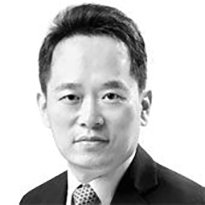A critical lack of safety infrastructure

The author is an editorial writer of the JoongAng Ilbo.
Who would imagine being crushed to death while on a night on the town? While the entire nation is depressed, messages of condolences are pouring in from abroad. Analyses of this tragedy also follow. “Overall safety insensitivity” and “lack of preventive measures by related authorities” are basic. Experts offer scientific analyses. Some say that it is a “crowd avalanche” when too many people come together and a “turbulent phenomenon” of being pushed around in a dense crowd.
Among various analyses, an outline of the accident is also being revealed. I think the key is “neglected risk.” First of all, any illegal building by the Hamilton Hotel should not be treated lightly. The hotel violated the 4-meter (13-feet) width regulation for alleyways in commercial districts to turn an already narrow alley into a 3.2-meter alleway. An illegal steel wall partition was installed over 10 years ago, but the Yongsan District Office never cracked down. The illegal structure may be the critical grounds for the “turbulent phenomenon.” This is an extreme case of bottlenecks commonly experienced at crowded toll gates or concert hall entrances. The illegal structure of the Hamilton Hotel was a neglected risk.
The district office said, “We confirmed after the incident that it was an unauthorized structure.” The administrative office is in charge of protecting the safety and lives of the residents. Could it avoid accountability just by claiming that it was not aware of a structural deformity? In fact, if you look around, there are many strange structures not only in city centers but also in residential areas. The administration that ignores respect for people eventually threatens safety and leads to accidents. It is a result of neglecting core values of people’s well-being and happiness.
Authorities’ lack of safety awareness over crowd accidents should be held accountable. The Ministry of the Interior and Safety surely knows about the crowd crush in Lan Kwai Fong, Hong Kong, which led to 21 deaths on New Year’s Eve in 1993. If the ministry was not aware, “safety” in the name of the ministry is meaningless. Civil servants and politicians use taxpayers’ money for overseas training, but what have they learned? After the disaster in Hong Kong, the local police control the number of people entering an area to protect people in the city. In April 1994, 94 people were crushed to death at Hillsborough Stadium in England. Danger is lurking anytime, anywhere.
The accountability over the lack of safety management by the Itaewon Merchants Association and the issue of the subway not skipping the station is in debate. Not one can be named as a cause. The accident was jointly caused by neglected risk of physical bottlenecks and poor safety precautions by the related authorities. The ultimate responsibility lies with the government. Even if there is no one organizer for the event, the state must work harder on safety.
There had been reports of “possible death by crush” four hours before the disaster, but the youngsters were not protected. A police line, which is so commonly seen in Seoul, was not in place, and authorities were lukewarm about responsive measures such as making the alley one way. As the fundamental system is poor, the responses were inevitably poor. Will reprimanding police officers solve the problem?
Why do major disasters continue to occur? In short, fourth-rate politics and third-rate administration are responsible. When a disaster occurs, politicians engage in disputes rather than building a safety system. Just as the root cause of the Sewol ferry disaster was reducing equilibrium water and overloading of freights, the illegal structure that creates a bottleneck in the alleyway was critically neglected in Itaewon. When the ship was sinking in the waters off South Jeolla eight years ago, the high school students were told, “Stay still,” and when the victims in Itaewon cried out, “I am being crushed to death” on Saturday, they were not saved.
If politicians fight over this issue, a safe society will not come. They must change after the tragic deaths of the innocent sons and daughters. When the overall social system changes, we can finally build a safe society. I am sorry and saddened for failing to protect the young from the neglected danger.










with the Korea JoongAng Daily
To write comments, please log in to one of the accounts.
Standards Board Policy (0/250자)